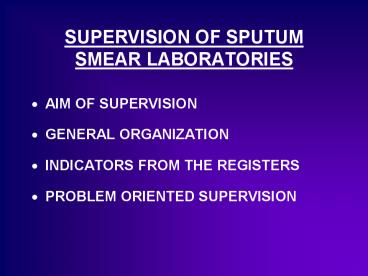SUPERVISION OF SPUTUM SMEAR LABORATORIES - PowerPoint PPT Presentation
1 / 23
Title:
SUPERVISION OF SPUTUM SMEAR LABORATORIES
Description:
Safety cabinets for smears?? unproven risk ; RR in high prevalence countries? ... self-made cabinets ? UV lamps rarely useful. lighted only after the work ... – PowerPoint PPT presentation
Number of Views:152
Avg rating:3.0/5.0
Title: SUPERVISION OF SPUTUM SMEAR LABORATORIES
1
SUPERVISION OF SPUTUM SMEAR LABORATORIES
- AIM OF SUPERVISION
- GENERAL ORGANIZATION
- INDICATORS FROM THE REGISTERS
- PROBLEM ORIENTED SUPERVISION
2
ESTABLISHING A MICROSCOPY NETWORK
- PYRAMIDAL STRUCTURE
- DECIDE ON THE REQUIRED DENSITY
- DECIDE ON METHODS / TECHNIQUES
- ENSURE LAB SAFETY
- CHOOSE ESSENTIAL EQUIPMENT
- ORGANIZE SUPPLIES
- ORGANIZE TRAINING
3
STRUCTURE OF MYCOBACTERIOLOGY SERVICES
- Pyramidal structure recommended
- to maintain proficiency
- e.g. susceptibility testing
- but also smear!
- for maximum efficiency and cost-effectiveness
- depending on the economical situation
- e.g. culture up to which level?
4
PYRAMIDAL STRUCTURE
- Three main levels
- (national) reference lab, specialised
- intermediary level district, region, province
- peripheral laboratories
- additionally
- peripheral treatment centres sputum sent up
- supra-national reference laboratories quality
assurance
5
PYRAMIDAL STRUCTURE (2)
- Role of the reference laboratory
- decisions on technical issues, with NTP
- e.g. equipment, supplies
- e.g. appropriate threshold for smear-positivity
- organization of, participation in
- training
- supervision
- quality control of smear microscopy
- training, supervision, quality control cultures
- (all) susceptibility tests, surveys
- (operational) research
- routine smears, cultures.. for its capture area
6
PYRAMIDAL STRUCTURE (3)
- Intermediate level labs
- with NTP supervisors
- main level for
- training of microscopists
- supervision of smear laboratories
- quality control of smears
- supplies to peripheral laboratories
- preparation, distribution of stains
- routine tasks
- including culture?
7
PYRAMIDAL STUCTURE (4)
- Peripheral laboratory network
- only AFB-microscopy
- eventually catering to subcenters
8
DECIDE ON THE REQUIRED DENSITY
- On average 1 center per 100,000 population
- Factors to consider
- workload and proficiency
- case-detection of sm TB per 100,000
- accessibility /- 25 km radius ?
- area/2000 (sq. km)
- existing infrastructure (survey)
- Find a balance
- referral of patients or samples
- big specialized centers
9
DECIDE ON METHODS AND TECHNIQUES
- Ziehl-Neelsen still the most appropriate
- technically simple, but tough
- prefer hot over cold method
- decide on cut-off for positivity
- Concentration techniques to increase sensitivity
(HIV) ? - quality of technician most important
- Fluorescence microscopy reference centers
- much more efficient human factor
10
ENSURE LAB SAFETY
- Transmission of TB aerosols
- main danger patients !!
- never collect sputum indoors
- stirring, pipetting, centrifugation of sputum
- use of gloves ??
- Safety cabinets for smears??
- unproven risk RR in high prevalence countries?
- expensive dangerous if not well maintained
- self-made cabinets ?
- UV lamps rarely useful
- lighted only after the work
11
ENSURE LAB SAFETY (2)
- Emphasis on light, ventilation, safe practices
- careful handling of sputum and unstained smears
- exhaust fan during work (cold climates)
- laboratory coats
- disinfection of working surface, paper covers
- Insist on safe disposal of infectious waste
- best by autoclaving(?), or burning
- disposables, e.g. bamboo sticks for smearing
12
(No Transcript)
13
CHOOSE ESSENTIAL EQUIPMENT
- Good microscopes needed, no false economy
- free of fungus and provisions to keep it so!
- protect from dust and sand in dry climates
- Also essential
- good table and chair for comfortable work
- slideboxes for quality control
- waste receptacle
- with cover also to be used for burning
- Not absolutely needed
- safety cabinets / laminar flow cabinets
- bacteriological loops, timers
14
(No Transcript)
15
(No Transcript)
16
(No Transcript)
17
ORGANIZE SUPPLIES
- Preparation of stains
- needs additional equipment and skills
- centralize at intermediate level
- precautions against contamination
- distilled water, absolutely clean glassware
- test and date each batch of stains
- low positives, 1 staining cycle
- negatives, 2-3 staining cycles
- Prefer non-drying immersion oil over cedar-oil
- Foresee bulbs and spares for microscopes
- Ordering and distribution system
18
X
X
X
X
X
19
(No Transcript)
20
(No Transcript)
21
ORGANIZE TRAINING
- Selection of people!
- motivation more important than education
- Emphasis on practice
- Duration of the course will be limited
- teaching of theoretical part
- correct practice
- Count on an in-service period
- all positives checked on the spot
- quality control for negatives
- Expertise can be acquired quickly in a
high-prevalence situation
22
(No Transcript)
23
(No Transcript)































